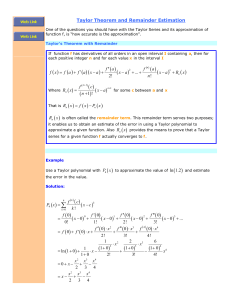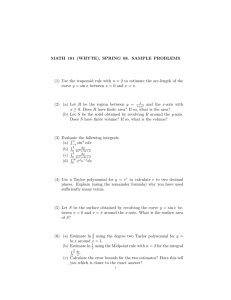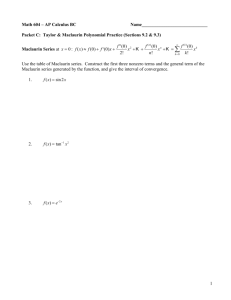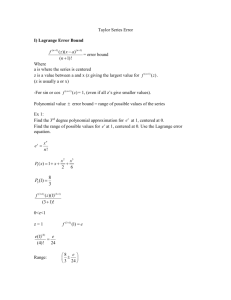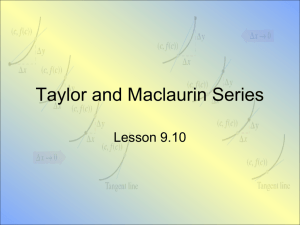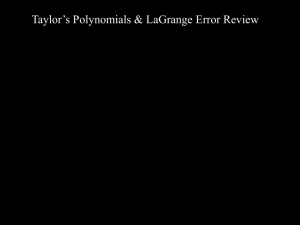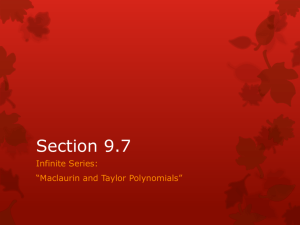Taylor Series
advertisement
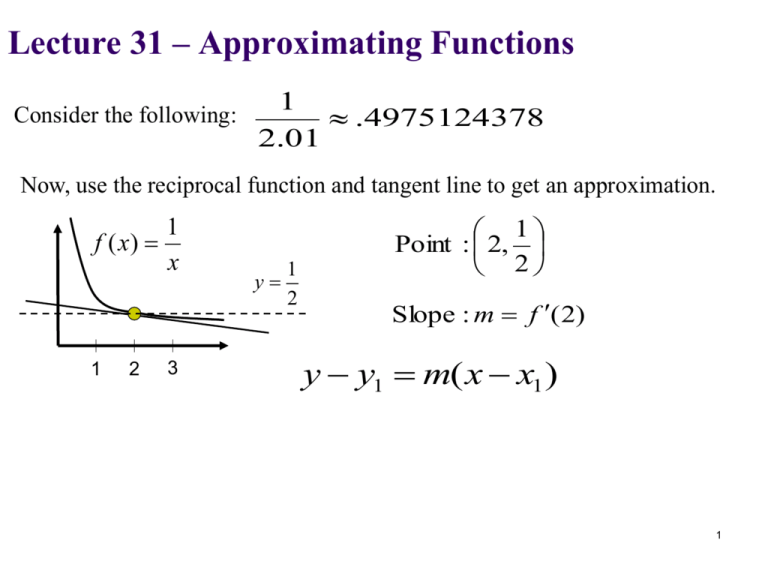
Lecture 31 – Approximating Functions Consider the following: 1 .4975124378 2.01 Now, use the reciprocal function and tangent line to get an approximation. f ( x) 1 2 1 x 3 y 1 2 1 Point : 2, 2 Slope : m f ( 2) y y1 m( x x1 ) 1 1 .4975124378 2.01 1 f ( x) x 1 y 2 2 1 L ( 2.01) 2.01 2.01 1 Point : 2, 2 Slope : m f ( 2) L( x) f (2) f (2)( x 2) 1 4 2 First derivative gave us more information about the function (in particular, the direction). For values of x near a the linear approximation given by the tangent line should be better than the constant approximation. Second derivative will give us more information (curvature). For values of x near a the quadratic approximation should be better than the linear approximation. 3 What quadratic is used as the approximation? p2 ( x) c0 c1 ( x a) c2 ( x a) 2 Key idea: Need to have quadratic match up with the function and its first and second derivatives at x = a. 4 1 .4975124378 Use p2(x) to get a better approximation. 2.01 f (a) 2 1 1 p ( x ) f ( a ) f ( a )( x a ) ( x a ) f ( x) f ( 2) 2 2 x 2 f ' ( x) 1 x2 f ' ( 2) f '' ( x ) 2 x3 f '' (2) f ( x) 2 1 x 2.01 1 4 1 4 1 p2 (2.01) 2.01 5 f ( x) e Graphical Example at x = 0 f ( x) e (2 x) x2 2 xe x2 f ( x) (2 x)(e e x2 x2 x2 (2 x)) (e x2 )(2) (4 x 2) 2 p0 ( x) p1 ( x) p2 ( x) 6 1 2 3 What higher degree polynomial is appropriate? Key idea: Need to have nth degree polynomial match up with the function and all of its derivatives at x = a. pn ( x) c0 c1 ( x a) c2 ( x a) cn ( x a) 2 n pn' ( x) pn'' ( x) pn ( n) ( x) 7 The coefficients, ck, for the nth degree Taylor polynomial approximating the function f(x) at x = a have the form: n p n ( x ) ck ( x a ) k k 0 8 Lecture 32 – Taylor Polynomials Def: The Taylor polynomial of order n for function f at x = a: k n pn ( x ) f k 0 (a) k ( x a) k! The remainder term for using this polynomial: Rn ( x) f ( x) pn ( x) for some c between x and a. where M provides a bound on how big the n+1st derivative could possibly be. 9 Estimate the maximum error in approximating the reciprocal function at x = 2 with an 8th order Taylor polynomial on the interval [2, 3]. 1 f ( x) x 1 f ' ( x) 2 x (8) f (2) f (2) 2 p8 ( x) f (2) f (2)( x 2) ( x 2) ( x 2)8 2! 8! R8 ( x) f (9) (c ) 9 ( x 2) 9! 2 f '' ( x ) 3 x 6 f ''' ( x) 4 x f ( 4) 24 ( x) 5 x 10 Rn ( x) M R8 ( x) f xa (n 1)! | x2| (c ) 9 ( x 2) M 9! 9! (9) n 1 9 11 What is the actual maximum error in approximating the reciprocal function at x = 2 with an 8th order Taylor polynomial on the interval [2, 3]? 1 f ( x) x (8) f (2) f (2) p8 ( x) f (2) f (2)( x 2) ( x 2) 2 ( x 2)8 2! 8! R8 (3) 1 p8 (3) 3 12 What nth degree polynomial would you need in order to keep the error below .0001? 1 f ( x) x (n) f (2) f (2) 2 pn ( x) f (2) f (2)( x 2) ( x 2) ( x 2) n 2! n! ( n 1) f (c) Rn ( x) ( x 2) n1 (n 1) ! f (n) n! ( x) (1) n 1 x n f ( n 1) ( x) (1) n 1 n 1! x n2 13 ( n 1) f (c ) n 1 Rn ( x) ( x 2) (n 1) ! To keep error below .0001, need to keep Rn below .0001. 14 Lecture 33 – Taylor Series The Taylor series centered at x = a: n f n 0 is a power series with (a) n ( x a) n! cn f (n) (a) n! The Taylor series centered at x = 0 is called a Maclaurin series: n 0 f n (0) n x n! 15 Example 1 Find the Maclaurin series for f (x) = sin x. f ( x) sin x f ' ( x) cos x f '' ( x) sin x f ''' ( x) cos x f ( 4) ( x) sin x sin x n 0 f n (0) n x n! f (0) 2 f ( k ) (0) k f (0) f (0) x x x 2! k! 16 Example 2 Find the Maclaurin series for f (x) = ex. f ' ( x) e x f ( x) e x e x n 0 f f '' ( x) e x f ( n ) ( x) e x n (0) n x n! f (0) 2 f ( k ) (0) k f (0) f (0) x x x 2! k! 17 For what values of x will the last two series converge? x 2 k 1 sin x k 0 (2k 1) ! x 2 n 3 2n 1! lim n ( 2n 3)! x 2 n 1 Ratio Test: Series converges for k x e k 0 k ! x Series converges for x n 1 n ! lim n n ( n 1)! x 18 y1 x Consider the graphs: 3 5 7 x x x sin x x 3! 5! 7 ! 1 x3 y3 x 63 x x5 y5 x 6 120 3 5 7 x x x y7 x 6 120 5040 19 Example 3 Find the Maclaurin series for f (x) = ln(1 + x). f ( x) ln( 1 x) f ' ( x) ln( 1 x) n 0 f 1 1 x f '' ( x) 1 1 x 2 f ''' ( x) 2 6 ( 4) f ( x ) (1 x) 4 1 x 3 n (0) n x n! f (0) 2 f ( k ) (0) k f (0) f (0) x x x 2! k! 20 For what values of x will the series converge? 2 3 4 k x x x k 1 x ln( 1 x) x 1 2 3 4 k k 1 x n 1 n lim n n n 1 x 21 Example 4 k x x x x x e 1 x 2 ! 3! 4 ! k 0 k ! 2 3 4 Creating new series for: f ( x) e x2 22 Lecture 34 – More Taylor Series Create and use other Taylor series like was done with power series. sin x 2 k 1 (1) x x3 x5 x7 x 3! 5! 7 ! k 0 (2k 1) ! k cos x cos x 23 Example 1 cos x x x 2 x3 1 2! 4! 6! 2 cos x 2 x lim 2 x x 2 cos x 2 cos x 2 x 2 cos x 2 x x2 24 Example 2 x 2 x3 x 4 ln( 1 x) x ... 2 3 4 3 lim x ln 1 x x 25 Example 3 e x 2 3 4 x x x 1 x 2 ! 3! 4 ! k x k 0 k ! ex x dx 26 Example 4 1 sin x (1) k x 2 k 1 x3 x5 x7 x 3! 5! 7 ! k 0 (2k 1) ! sin( x ) dx .3102683 0 2 27 Example 5 .2 0 x 2 x3 x 4 ln( 1 x) x ... 2 3 4 ln( 1 t ) dt .19080014 t 28

